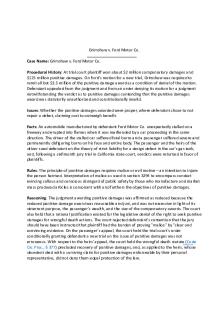Module 2 Discussion 1 A Case Study of Welge v. Planters Lifesavers Co PDF

| Title | Module 2 Discussion 1 A Case Study of Welge v. Planters Lifesavers Co |
|---|---|
| Course | Business Law II |
| Institution | Southern New Hampshire University |
| Pages | 1 |
| File Size | 55.2 KB |
| File Type | |
| Total Downloads | 88 |
| Total Views | 116 |
Summary
Module 2 Discussion 1 case study analysis of Welge v. Planters Lifesavers Co. with no replies...
Description
The case of Welge v. Planters Lifesavers Co. is a case of liability. Welge had a glass jar of peanuts on the top of his refrigerator. Two weeks after he had it and grabbing peanuts a few times, the jar shattered as he was opening it, permanently impairing his hand. Welge filed product liability claims against K-Mart, the seller of the product; Planters, the manufacture of the peanuts; and Brockway, the manufacture of the glass jar. The district court granted the defendant’s motion for a summary of the judgment. Justice Posner reversed the district court’s decision (Kubasek et al., 2020, p. 257). Justice Posner used the theory of strict product liability. Under the theory plaintiffs must prove that the product was defective was when sold, the product was so defective that the product was unreasonably dangerous, and the product was the cause of the plaintiff’s injury (Kubasek et al., 2020, p. 256). Justice Posner proves that all three exist. The plaintiff’s injury supports the second and the third. The injury was caused by the glass shattering. The permanent impairment shows that the product was unreasonably dangerous. Justice Posner trusts the plaintiff’s word that the jar was not jostled while purchased at the store, traveling to Welge’s house, and being used. The plaintiff also used the normal amount of force when opening and closing the jar. Justice Posner reasons that normal people do not lock up their glass jars to prevent damage and that the plaintiff could not be expected to do so either. The product was defective when it was sold. Justice Posner also uses the doctrine res ipsa loquitur which “teaches that an accident is unlikely to occur unless the defendant is negligent, is itself circumstantial evidence that the defendant is negligent” (Kubasek et al., 2020, p. 257). Since the accident was not likely to happen given the plaintiff’s normal use, the occurrence of the accident is circumstantial evidence that the defendant is negligent. I agree with the judge’s decision. The defendants are liable. A glass jar should hold up in transit and endure normal use. However, I can also understand the defendant’s point of view. Besides the plaintiff’s word, there is no proof that they did not bang the jar and cause the defect. I do not agree that K-Mart should be even involved in this case though. They were not responsible for the manufacturing of the product. The defect was undetectable to Welge, so it was undetectable to KMart. Why should they be held liable for a product that they simply placed on their shelf? Reference Kubasek, N., Browne, M. N., Dhooge, L. J., Herron, D. J., Williamson, C., & Barkacs, L. L. (2020). Dynamic business law (5th ed.)....
Similar Free PDFs

24. Co Coast a case study
- 3 Pages

CASE Study PT 1 & 2 IRIS Module
- 5 Pages

Case Memo 1 Pepsi Co - Grade: A
- 3 Pages

Module 2 Discussion
- 3 Pages

Case Study Module 5 - Grade: A
- 6 Pages

A Case Study of Chandigarh
- 8 Pages

Module 1 Discussion 1-1
- 1 Pages

Module 1 discussion
- 1 Pages

Module 2 ARDS Online CASE Study
- 24 Pages

Module 2 - Case study d OC
- 1 Pages

Case study 1 - Grade: A
- 2 Pages
Popular Institutions
- Tinajero National High School - Annex
- Politeknik Caltex Riau
- Yokohama City University
- SGT University
- University of Al-Qadisiyah
- Divine Word College of Vigan
- Techniek College Rotterdam
- Universidade de Santiago
- Universiti Teknologi MARA Cawangan Johor Kampus Pasir Gudang
- Poltekkes Kemenkes Yogyakarta
- Baguio City National High School
- Colegio san marcos
- preparatoria uno
- Centro de Bachillerato Tecnológico Industrial y de Servicios No. 107
- Dalian Maritime University
- Quang Trung Secondary School
- Colegio Tecnológico en Informática
- Corporación Regional de Educación Superior
- Grupo CEDVA
- Dar Al Uloom University
- Centro de Estudios Preuniversitarios de la Universidad Nacional de Ingeniería
- 上智大学
- Aakash International School, Nuna Majara
- San Felipe Neri Catholic School
- Kang Chiao International School - New Taipei City
- Misamis Occidental National High School
- Institución Educativa Escuela Normal Juan Ladrilleros
- Kolehiyo ng Pantukan
- Batanes State College
- Instituto Continental
- Sekolah Menengah Kejuruan Kesehatan Kaltara (Tarakan)
- Colegio de La Inmaculada Concepcion - Cebu




